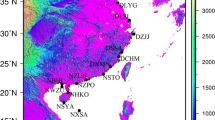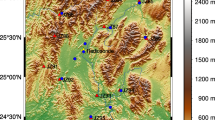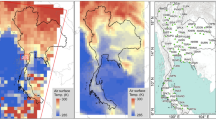Abstract
The latest ECMWF global reanalysis, ERA5, is able to provide hourly surface pressure and water vapor-weighted mean temperature (Tm), which are two key factors in GPS precipitable water vapor (PWV) retrieval. Performance of surface pressure, surface air temperature, and Tm derived from ERA5 and its predecessor ERA-Interim (ERAI) are evaluated by comparing with more than 2000 meteorological stations and 89 radiosonde stations in the year of 2016 over China. Average pressure error RMS is 0.7 hPa for ERA5, compared to 1.0 hPa for ERAI, and ERA5 pressure diurnal variations agree much better than ERAI with in situ measurements. Temperature and Tm differences between ERA5 and ERAI are relatively smaller, with error RMS of 1.8 K and 1.6 K for ERA5-derived temperature and Tm, respectively. PWV error contributed by reanalysis-derived parameters is also estimated. The ERA5-induced PWV error is generally less than 1 mm, with smaller errors (< 0.4 mm) in eastern China but larger errors (can exceed 0.6 mm) in northwestern China and in the southeast of the Tibetan Plateau. Diurnal variations of PWV retrieved using pressure and Tm from meteorological measurements (MET) and reanalysis products are compared. Good agreements are found between ERA5-based PWV and MET-based PWV in diurnal variations, while artificial diurnal signals are introduced in ERAI-based PWV, especially in the Tibetan Plateau. This study indicates that ERA5 can support high-accuracy hourly GPS PWV retrieval over China without contaminating the diurnal cycles, which is of great importance for historical GPS PWV retrieval at stations without collocated meteorological sensors equipped.











Similar content being viewed by others
Data availability
GPS data are provided by the National Earthquake Infrastructure Service which can be accessed from http://www.neiscn.org/. The ground meteorological data prepared by China Meteorological Administration (CMA) are available at http://data.cma.cn/. Radiosonde data are archived at https://www.ncdc.noaa.gov/data-access/weather-balloon/integrated-global-radiosonde-archive/. The reanalysis data, ERA5 and ERA-Interim products, are released by ECMWF at https://www.ecmwf.int/.
References
Betts A, Kohler M, Zhang Y (2009) Comparison of river basin hydrometeorology in ERA-Interim and ERA-40 reanalyses with observations. J Geophys Res Atmos 114:D2
Bevis M, Businger S, Herring TA, Rocken C, Anthes RA, Ware RH (1992) GPS meteorology: remote sensing of the atmospheric water vapor using the global positioning system. J Geophys Res 97:15787–15801
China Meteorological Administration (1979) Atlas of climate of the People’s Republic of China. SinoMaps Press, Beijing, p 226
Cressman GP (1959) An operational objective analysis system. Mon Wea Rev 87:367–374
Dai A, Wang J, Thorne PW, Parker DE, Haimberger L, Wang XL (2011) A new approach to homogenize daily radiosonde humidity data. J Clim 24:965–991
Dee DP et al (2011) The ERA-Interim reanalysis: configuration and performance of the data assimilation system. Q J R Meteorol Soc 137:553–597
Durre I, Vose RS, Wuertz DB (2006) Overview of the integrated global radiosonde archive. J Clim 19:53–68
Fujiwara M et al (2017) Introduction to the SPARC reanalysis intercomparison project (S-RIP) and overview of the reanalysis systems. Atmos Chem Phys 17:1417–1452
Hagemann S, Bengtsson L, Gendt G (2003) On the determination of atmospheric water vapor from GPS measurements. J Geophys Res 108:4678
Heise S, Dick G, Gendt G, Schmidt T, Wickert J (2009) Integrated water vapor from IGS ground-based GPS observations: initial results from a global 5-min data set. Ann Geophys 27:2851–2859
Hersbach H, Dee D (2016) ERA5 reanalysis is in production, ECMWF Newsletter, p 147. https://www.ecmwf.int/en/newsletter/147/news/era5-reanalysis-production. Accessed 11 Dec 2018
Jade S, Vijayan MSM (2008) GPS-based atmospheric precipitable water vapor estimation using meteorological parameters interpolated from NCEP global reanalysis data. J Geophys Res 113:D03106
Kiehl JT, Trenberth KE (1997) Earth’s annual global mean energy budget. Bull Am Meteorol Soc 78:197–208
Ma L, Zhang T, Li Q, Frauenfeld OW, Qin D (2008) Evaluation of ERA-40, NCEP-1, and NCEP-2 reanalysis air temperatures with ground-based measurements in China. J Geophys Res Atmos 113:D15115
Ning T, Wang J, Elgered G, Dick G, Wickert J, Bradke M, Sommer M, Querel R, Smale D (2016) The uncertainty of the atmospheric integrated water vapour estimated from GNSS observations. Atmos Meas Tech 9:79–92
Reuten C, Moore RD, Clarke GKC (2011) Quantifying differences between 2-m temperature observations and reanalysis pressure-level temperatures in northwestern North America. J Appl Meteorol Climatol 50:916–929
Saastamoinen J (1972) Atmospheric correction for the troposphere and stratosphere in radio ranging satellites. Use of Artif Satell Geod 15:247–251
Shi C, Zhao Q, Geng J, Lou Y, Ge M, Liu J (2008) Recent development of PANDA software in GNSS data processing. In: Li D, Gong J, Wu H (eds) International conference on earth observation data processing and analysis (ICEODPA). International Society for Optical Engineering (SPIE Proceedings), vol 7285
Trenberth KE, Fasullo J, Smith L (2005) Trends and variability in column-integrated atmospheric water vapor. Clim Dyn 24:741–758
Wang J, Zhang L, Dai A (2005) Global estimates of water-vapor-weighted mean temperature of the atmosphere for GPS applications. J Geophys Res 110:D21101
Wang J, Zhang L, Dai A, Van Hove T, Van Baelen J (2007) A near-global, 8-year, 2-hourly data set of atmospheric precipitable water from ground-based GPS measurements. J Geophys Res 112:D11107
Zhang W, Lou Y, Haase J, Zhang R, Zheng G, Huang J, Shi C, Liu J (2017) The use of ground-based GPS precipitable water measurements over China to assess radiosonde and ERA-Interim moisture trends and errors from 1999 to 2015. J Clim 30:7643–7667
Zhang W, Lou Y, Huang J, Zheng F, Cao Y, Liang H, Shi C, Liu J (2018a) Multiscale variations of precipitable water over China based on 1999–2015 ground-based GPS observations and evaluations of reanalysis products. J Clim 31:945–962
Zhang W, Lou Y, Huang J, Liu W (2018b) A refined regional empirical pressure and temperature model over China. Adv Space Res 62:1065–1074
Zhao T, Guo W, Fu C (2008) Calibrating and evaluating reanalysis surface temperature error by topographic correction. J Clim 21:1440–1446
Zhou C, He Y, Wang K (2018) On the suitability of current atmospheric reanalyses for regional warming studies over China. Atmos Chem Phys 18:8113–8136
Acknowledgements
This work was supported by the National Key Research and Development Program of China (2016YFB0501800), the National Natural Science Foundation of China (41774036; 41804023), the China Postdoctoral Science Foundation funded project (2017M622518), and the Natural Science Foundation of Hubei Province of China (2018CFB193).
Author information
Authors and Affiliations
Contributions
H. Liang, W. Zhang and Y. Lou designed the research; W. Zhang, H. Zhang, Y. Zhou and W. Liu analyzed the data; Y. Lou, Y. Cai and Y. Cao performed the research. W. Zhang drafted the paper; all authors discussed and commented on the manuscript.
Corresponding author
Rights and permissions
About this article
Cite this article
Zhang, W., Zhang, H., Liang, H. et al. On the suitability of ERA5 in hourly GPS precipitable water vapor retrieval over China. J Geod 93, 1897–1909 (2019). https://doi.org/10.1007/s00190-019-01290-6
Received:
Accepted:
Published:
Issue Date:
DOI: https://doi.org/10.1007/s00190-019-01290-6




